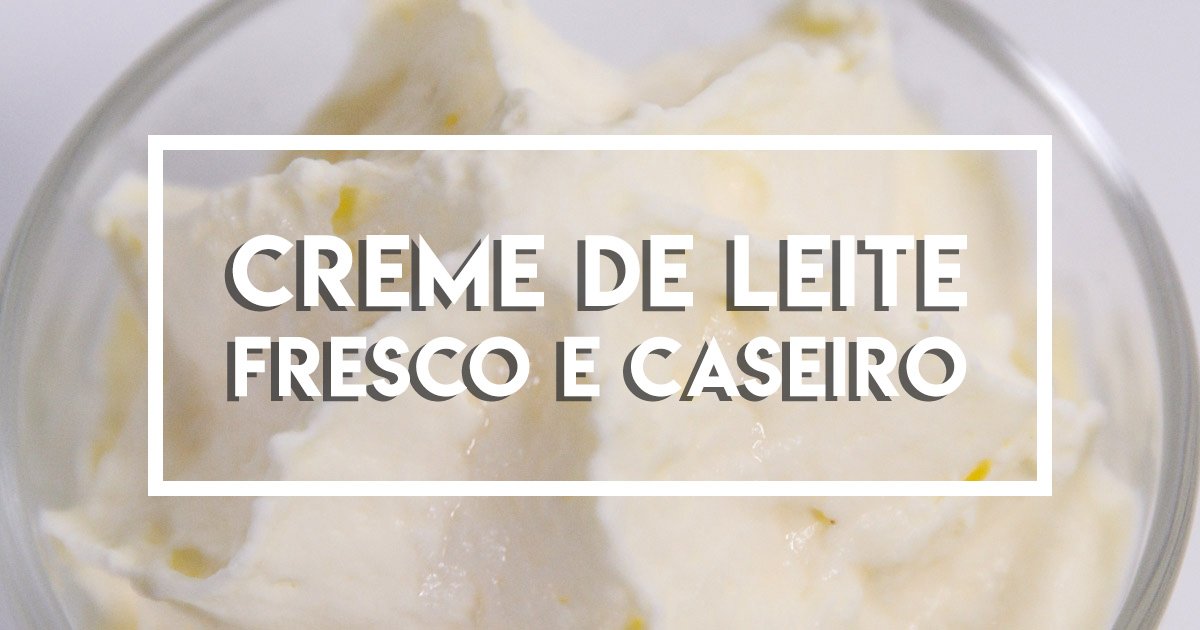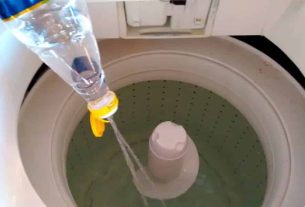From time to time, I get some suggestions of famous recipes on the internet. A very recurrent was such a Homemade Fresh Milk Cream! Is it worth it? Or rather, does it work?
Some time ago, I had already tested some alternatives to whipped cream (as not replacing Chantilly), but not to the cream itself in the fat.
Recipes for homemade milk cream exist in droves with the most varied ingredients. From creams with eggs, egg yolks, espessantesthickeners and emulsifiers.
While, others use only milk and fats.
Just to make it clear: I performed the test out of curiosity, I wanted to know how I would behave comportarand it would work. I’m not here to judge anyone who uses or teaches. I want bullshit with anyone, haven’t you?
Bejos de lux. “sce scene smashing icing sugar”.
How were the creams made
There are several recipes for cream substitutes and / or whipped cream, I had already tested others for whipped cream that did not work at all. Read more: How not to replace Chantilly.
This time, I wanted to see simpler alternatives. Some ordered eggs, yolks, emulsifiers and the like. While, others were just milk and some fat source.
I ended up opting for two versions that varied in relation to the source of fat: 100% butter, and mixed butter and hydrogenated vegetable fat.
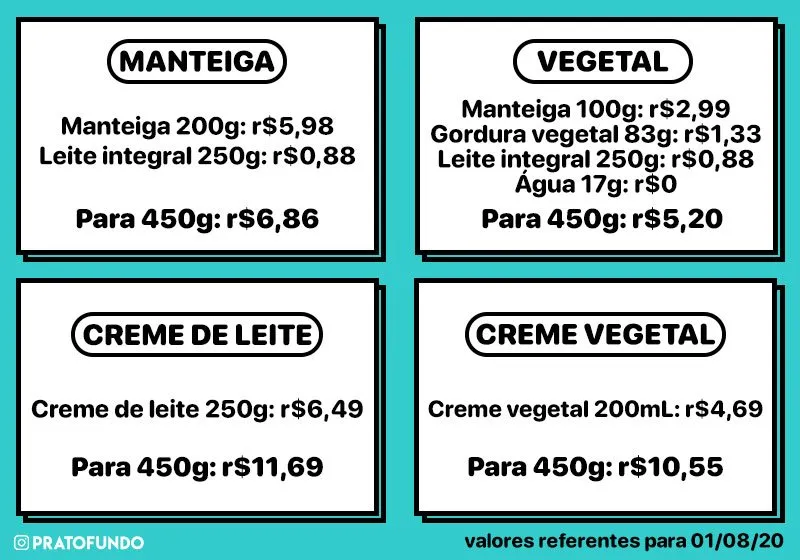
Fat Content of the Ingredients:
- Butter: 83% fat
- Whole milk: 3% fat
- Vegetable Fat: 100% Fat
The fat contents of the ingredients were calculated indirectly using the information in the nutritional table of the packaging. And yes, I know that this data is done by sampling and can vary.
I opted for these quantities because of the fat content, process facility and calculation.
Base Butter:
- 200g butter: 166g fat
- 250g whole milk: 7.5g fat
- Total fat: 173,5g
Base Butter and Fat Vegetable:
- 100g butter: 83g fat
- 83g fats vegetable: 83g fat
- 250g whole milk: 7.5g fat
- 17g water: 0g fat
- Total fat: 173,5g
In the end, the amount produced of each of the versions was 450g with 38.5% fat. Which is a good content, after all, for a c recme d’m “fresh” turn whipped cream is necessary for the lowest 35% fat.
In the version the mixture of butter and fat has the addition of water to complete the amount of 450g.
Yes, breathe. Calm it.
Since it was to test, let’s test. Therefore, I chose the version with vegetable fat that we also found on the internet. The cost of fat is much lower than that of butter.
How to prepare
The preparation mode is super simple and equal for both versions.
- 250g of whole milk were heated to 70-75oC (in the plant base was added 17g of water) and removed from heat;
- 200g unsalted butter (for butter) and 100g butter in salt and 83g of hydrogenated vegetable fat (for vegetable basis) added in the warm milk, separately;
- I blended until I melted the fats.
- Each version was tapped in the blender for 3 minutes at maximum power (the blender indicates to be 450 watt);
- Each version was stored in a container with lid and taken to the refrigerator for 24 hours;
- A portion of 200g of each were beat at medium-high speed in the mixer to ride whipped cream, the total beat time was 2 minutes and 20 seconds;
- In the final seconds were added 20g of icing sugar, then stored in the refrigerator until the time of use/sorry.
The cost of production
One of the reasons (if not, the main one) to make the cream at home is the cost. Following the availability of the product when we think about the size of Brazil, in some regions it is much more difficult to find.

The values for the calculation are related to August 1, 2020 (will vary with time and region), and indicate the cost of the ingredient in the amount used in the recipe. That is, 200g of butter cost me r$5,98; 250g of milk cost $0.88 and so on.
Base Butter:
- Butter 200g: r$5.98
- Full milk 250g: r$0.88
- Total for 450g: r$6.86
Base Butter and Fat Vegetable:
- Butter 100g: r$2.99
- Vegetable fat: r$1.33
- Full milk 250g: r$0.88
- Water 34g: I did not consider the cost
- Total for 450g: r$5.20
“fresh” milk cream 40% fat:
- Cream of milk 250g: r$6.49
- Total for 450g: r$11.69
Vegetable Cream type Chantilly:
- Vegetable Cream 200mL: r$4,69
- Total for 450g: r$10.55
As a comparative I also put the cost of the “fresh” milk cream (even, the product) and its substitute, the vegetable cream type Chantilly. Read more: Plant Creed type Chantilly and Comparative Vegetable Creams.
By cost, the home versions are much cheaper in the same amount (analyzing only the cost of producing the ingredients).
The cote-based version of Butter is 70% cheaper than the “fresh” “fresh” milk Cream purchased. For cost, perhaps, it is worth it.
It is noteworthy that the product Creme Vegetable type Chantilly increases about 4 times of volume, that is, the yield is higher.
But it’s not all that simple, is it?
Working, it worked…
My big doubt about these homemade recipes for fresh cream was precisely whether I would ride. If when hitting, it would turn whipped cream or at least incorporate air and turn a foam.
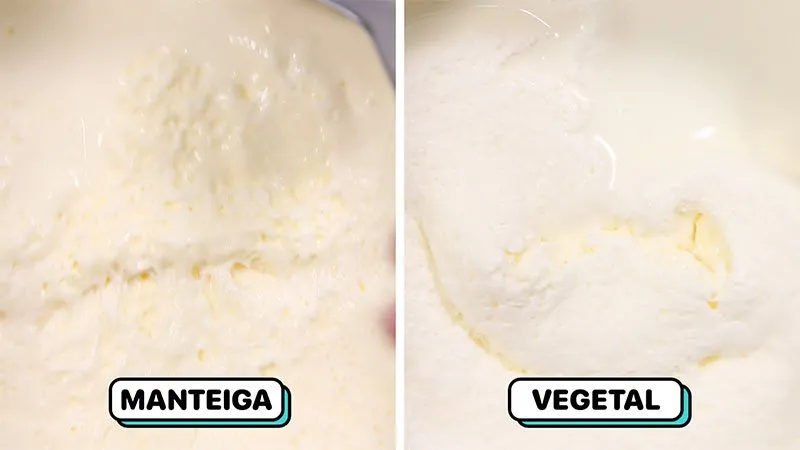
After 24 hours in the refrigerator, when opening the two versions it was possible to notice a layer of fat on the surface. What is even normal, in some versions of fresh cream bought it also happens.
Super iceds super geladoswere beaten (200g of each), separately, until they reached a point of soft peaks / Chantilly, the total time was 2 minutes and 20 seconds. And in the final seconds I added icing sugar (20g in each), because I wanted it to dissolve faster.
He turned whipped cream, wow! Less bad. But at least in my emulsion test, and the foam is final, they are very, very unstable. The stability is super low, even in the refrigerator.
The mixture of both versions began to separate after 10 minutes of beats, and that was inside the refrigerator.
– Is it hot?
If you eat without knowing anything: it is almost impossible to notice any difference.
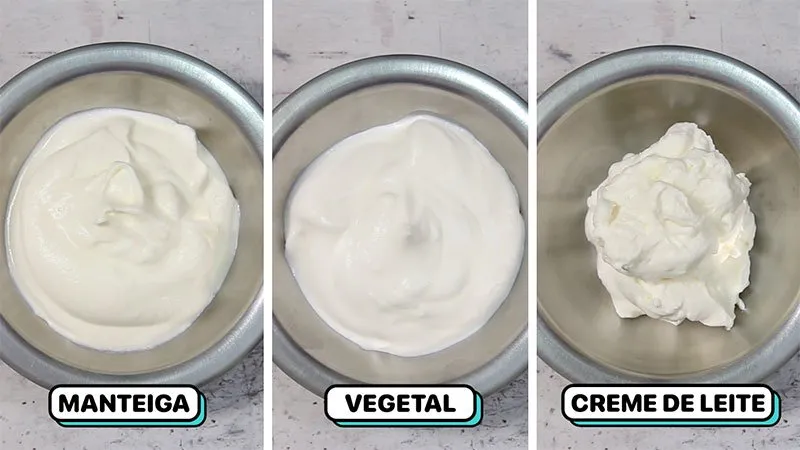
It has flavor and texture of purchased sour cream. In the test, as I tasted side by side, and having as reference the cream of milk, I could realize that they were different.
But again, just having one side on the other. If you didn’t have a comparison parameter: I would say it would be very difficult.
The version with butter is the one that has the most dairy flavor present, while the fat version is softer suaveand resembles the vegetable cream type Chantilly, but without that flavor of flavoring itself.
Yes: I ameamy pure cream. A minute of silence for my liver.
As I am not a savage, I tested in a super simple and classic preparation: Chantilly with sigh and berries.
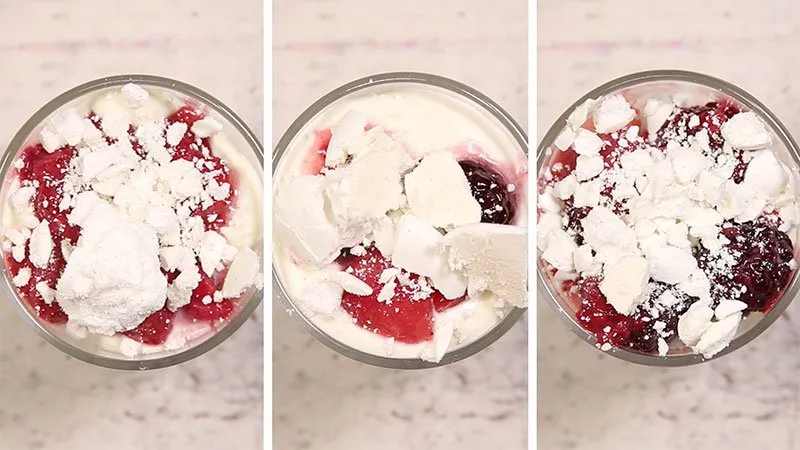
In this trio: too hot. And it is practically impossible to notice any difference in flavor. The texture is more compromised because of the fruits (over moisture), but it is something expected.
In time: the taste may vary depending on the butter used, some brands have a very characteristic taste.
I took advantage and did two more tests: stability estabilidadeof the Chantilly siphon.
Stability Test
In the stability test: I separated a 50g portion of each one of them, and also compared the cream purchased. I left out the refrigerator for 1 hour, on the day it was not particularly hot (25-27oC).
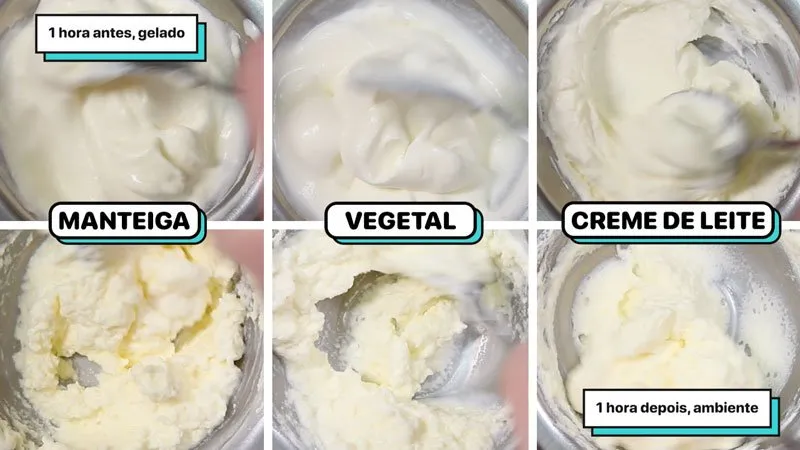
After time, it was noticeable how unstable the preparations are. Both the butter and vegetable fat base begin to break down the emulsion: the mixture began to separate the fat from the liquid. It wouldn’t be a problem if they had been a little soft, but it was beyond that.
I tried to reincorporate by beating only the wire batter (fouet) and… then separated for good, and it was butter again.
One note: the whipped cream of purchased cream also began to become grainy, but because of the over-handling. As it had a higher fat content, it is easier to become butter.
The Siphon of Chantilly
As I had a good amount still without using, I decided to test on the Chantilly siphon as well.
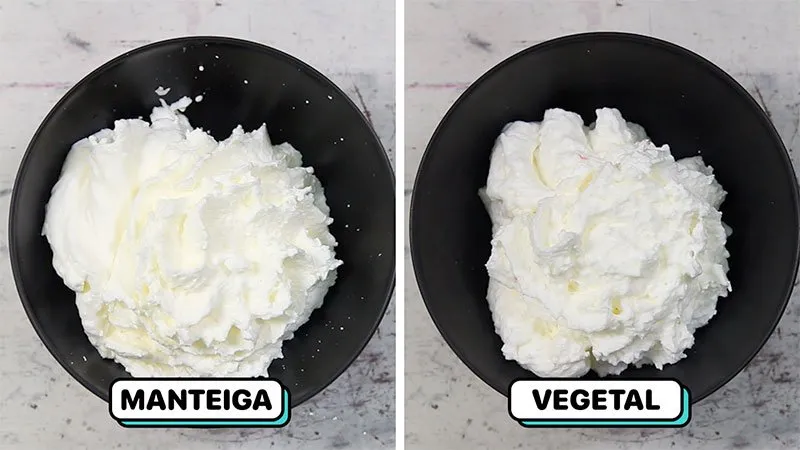
It worked as expected in siphon, the whipped cream formed. But in that delicate foam that the siphon usually produces, then, is of only immediate. Pretty unstable.
And due to the excess of charge (believe me), the taste of whipped cream was much softer both in the milky feeling and in the sweet taste.
Is it worth it?
For cost: yes. By usability: it does not pay, the risk is too great.
In this case, I am considering that the use is to turn the cream into whipped cream. That is, you will hit to assemble it, and turn a foam. You want aeration in the cream.
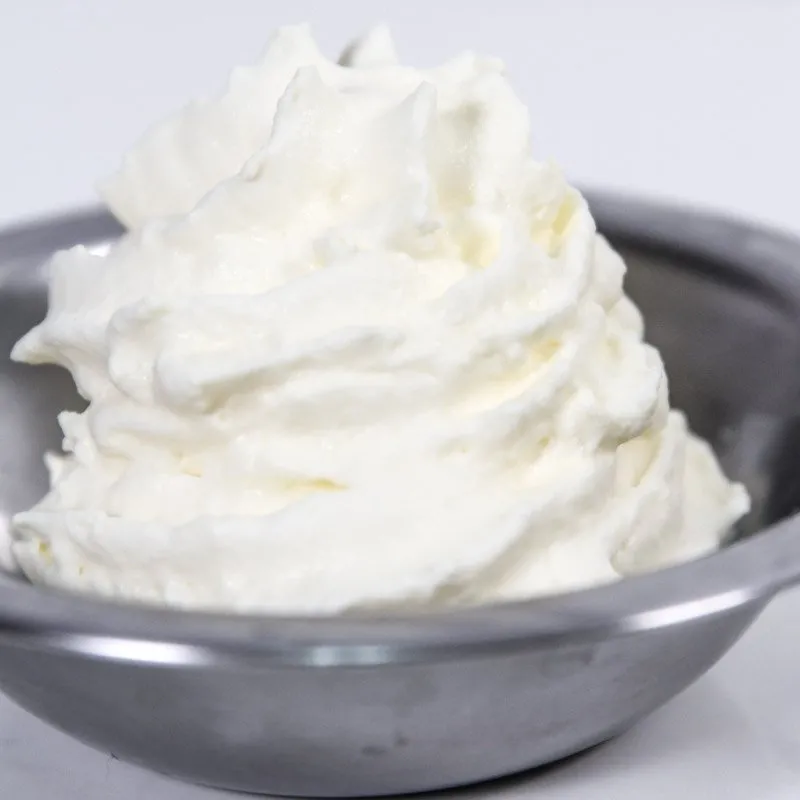
Non-existent stability
My biggest shock was the lack of stability even inside the refrigerator and the day was not even hot. I wondered: to think about this on a summer day on a cake? It’s asking to melt.
Perhaps one of the reasons is the beating of the mixture in the liquidificadorblender: because it is a domestic equipment, I know that it does not have the potency or the effectiveness of an industrial machinery. This influences the ability to incorporate, decrease and homogenize the fat globules in milk.
That’s what my blender is not the simplest, but it’s not super potent. I already knew that. Maybe yours will work? Maybe, but I doubt it.
If you are to have all this work and time (remember: it takes at least 24 hours of pre-preparing) and you are going to use to mix with other ingredients and / or the recipe does not require the aeration of the cream, I have my doubts there to do it at home.
For many national recipes, we (you and I) have already adapted to use the milk cream of the box (Read more: All about Milk Cream). Yes, of course, it has less fat. But there are other easier ways to add fat.
Durability , Durability
Another detail must be seen: durability. Unlike the cream of milk purchased, this made at home is not pasteurized.
As much as it is used box milk (which is UHT, Ultra-High Temperature, ultra high temperature) and butter is made with pasteurized cream.
Our homemade version did not go through a pasteurization process after it was ready. As much as the milk has been watered to melt fats, as much as the kitchen and utensils are clean, it is normal for the kitchen to have a microbiological load on it. After all, it is an exposed environment, has a window, has a current, has people passing by.
And it’s all right. Don’t despair want to clean up everything.
So, like any other preparation made in a home kitchen: the homemade milk cream will also have a microbiological load that influences its durability. And because it is something liquid and with i gredientes super nutritious, it is easier to spoil.
Thus, analyzing all the factors, for me it does not pay. Fall into that famous saying: the cheap that is expensive.
Thanks
I would like to thank the supporters PratoFunders: with this support I can dedicate myself to writing more complete and detailed texts like this. Learn how you can be a part of: Support the Fucking Plate!

Sign up for our newsletter and stay up to date with exclusive news
that can transform your routine!
Warning: Undefined array key "title" in /home/storelat/public_html/wp-content/plugins/link-whisper-premium/templates/frontend/related-posts.php on line 12
Warning: Undefined array key "title_tag" in /home/storelat/public_html/wp-content/plugins/link-whisper-premium/templates/frontend/related-posts.php on line 13

